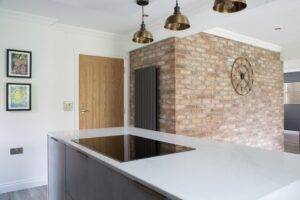Brick slips – the name may sound unfamiliar, but these versatile little wonders are making a big splash in the world of interior and exterior design. With their ability to effortlessly transform any space into a rustic, industrial or contemporary masterpiece, it’s no wonder that brick slips are gaining popularity as a go-to wall covering option.
Gone are the days when bricks were limited to traditional construction purposes. Today, more and more people are embracing the beauty and practicality of using brick slips to create stunning feature walls both inside and outside their homes. From stylish loft apartments to cozy country cottages, brick slips have become an essential tool for homeowners looking to add character and charm to their living spaces.
In this blog post, we will explore why brick slips have become such a sought-after choice for wall coverings. We’ll delve into their advantages over traditional bricks, discuss various types of brick slips available in The Brick Tile Company, examine the installation process involved, compare maintenance requirements with conventional bricks, and finally weigh up the costs involved. So buckle up as we take you on a journey through the wonderful world of brick slips!
Advantages of using external and internal brick slips as a wall covering
Brick slips have gained immense popularity in recent years as a versatile wall covering option for both external and internal surfaces. These thin slices of real brick offer numerous advantages over traditional bricks, making them an attractive choice for homeowners, designers, and architects alike.
One major advantage of using brick slips is their flexibility when it comes to design. With various colors, textures, and finishes available, brick slips can effortlessly transform any space into a visually stunning one. Whether you prefer the rustic charm of weathered red bricks or the sleek elegance of white-washed bricks, there’s a style to suit every taste.
Another key benefit is the ease of installation that brick slips offer. Unlike traditional bricks that require skilled labor for construction purposes, brick slips can be easily adhered to existing walls using adhesive or mortar. This not only saves time but also reduces costs associated with extensive masonry work.
Furthermore, external brick slips provide excellent insulation properties by creating an additional layer on the building envelope. They help regulate temperature fluctuations by keeping interiors cool during summer months and warm in winter – leading to energy savings and reduced carbon footprint.
In addition to aesthetics and thermal benefits, maintenance is another area where brick slips excel. Due to their smooth surface finish, they are relatively easy to clean compare to textured exteriors such as stone or concrete cladding. Simply wiping them down periodically will keep them looking fresh and vibrant for years to come.
Moreover, when it comes to cost comparison with traditional bricks, brick slips often prove more economical due to their lightweight nature requiring less material consumption during transportation – resulting in lower shipping costs overall.
To sum up briefly (without concluding), choosing external or internal brick slips as your wall covering offers an array of advantages including diverse design options,
easy installation process, excellent insulation properties, low maintenance requirements and cost-effectiveness.
Different Types of Brick Slips
when it comes to brick slips, there is a wide range of options available to suit various design preferences and requirements. One popular type is the traditional clay brick slip. These slips are made from real fired clay bricks, giving them an authentic look and feel. They come in different colors and textures, allowing for customization and versatility in design.
For those looking for a more modern aesthetic, there are also concrete brick slips. Made from durable concrete materials, these slips offer a sleek and contemporary appearance. They can mimic the look of natural stone or have a smooth finish, depending on your preference.
Another option is Reclaimed style brick slips. These are sourced from old buildings or structures that have been demolished or renovated. Reclaimed bricks carry character and history with them, adding a unique charm to any space they are used in.
For those who prefer something more vibrant and eye-catching, there are even glazed brick slips available. These slips have a glossy surface and come in various bold colors that can make a statement in any room.
With such diversity in types of brick slips available today, homeowners and designers have endless possibilities when it comes to creating their desired aesthetic.
In addition to the variety of options mentioned above, manufacturers now offer custom-made brick slip designs as well. This means you can create your own unique patterns or mix different types together for an even more personalized touch.
Whether you prefer the timeless appeal of traditional clay bricks or the contemporary allure of concrete ones; whether you want to incorporate history through reclaimed bricks or add pops of color with glazed versions – there is undoubtedly a perfect type of brick slip out there for everyone’s taste!
The availability of such diverse options has contributed significantly to the growing popularity of using brick slips as wall coverings both internally and externally
Installation Process of Brick Slips
The Installing Brick Slips is relatively straightforward, making them a popular choice for both DIY enthusiasts and professional builders. Before beginning the installation, it’s important to ensure that the wall surface is clean, dry, and free from any loose debris.
Measure and mark out the area where the brick slips will be installed. It’s recommended to start at the bottom and work your way up to ensure a level finish. Apply a suitable adhesive or mortar mix onto the back of each slip using a notched trowel or similar tool.
Next, press each brick slip firmly into place on the wall surface, ensuring they are evenly spaced with consistent gaps between them. Use spacers if necessary to maintain an even layout. Once all the slips are in position, allow sufficient time for the adhesive or mortar to dry according to manufacturer guidelines.
After drying, remove any excess adhesive or mortar from between the slips using a pointing trowel or brush. This step helps achieve a neat and clean finish.
Depending on personal preference and desired aesthetic effect, you may choose to apply a protective sealant over the brick slips once they are fully dry. This can help enhance their durability and resistance against moisture penetration.
Overall the installation process of brick slips requires careful planning and attention to detail but can be achieved by following these simple steps
Maintenance and Cost Comparison with Traditional Bricks
When it comes to considering a wall covering option, maintenance and cost are two important factors that cannot be overlooked. Brick slips offer several advantages in terms of both maintenance and cost when compared to traditional bricks.
Maintenance-wise, brick slips require minimal upkeep. They do not require regular repainting or sealing like some other materials. A simple cleaning routine using mild detergent and water is usually sufficient to keep them looking fresh for years to come. Additionally, any damaged or discolored brick slips can easily be replaced individually without the need for extensive repairs.
In terms of cost, brick slips have a distinct advantage over traditional bricks. While the initial investment might be slightly higher due to the manufacturing process involved in creating brick slips, their lightweight nature makes installation easier and faster, reducing labor costs significantly. Moreover, because they are thinner than traditional bricks, transportation costs are also reduced.
Furthermore, when comparing long-term costs between brick slips and traditional bricks, it becomes apparent that brick slips provide better value for money. Their durability ensures longevity without compromising on aesthetics or quality.
Considering the low maintenance requirements coupled with potential cost savings in installation and transportation expenses make brick slips an attractive choice for those seeking a versatile wall covering solution with long-term benefits.
Conclusion:
Brick slips have undoubtedly emerged as a popular and versatile wall covering option for both external and internal spaces. With their numerous advantages, including easy installation, durability, flexibility in design options, and cost-effectiveness compared to traditional bricks, it’s no wonder they are gaining popularity among homeowners and designers alike.
Whether you want to enhance the exterior facade of your home or create a stunning feature wall inside your living room, brick slips offer endless possibilities. From rustic reds to sleek whites and everything in between, there is a brick slip style that can suit any aesthetic preference.
The installation process of brick slips may require some time and effort but can be easily accomplished with basic DIY skills. And once installed, maintenance is minimal compared to traditional bricks. The ability to simply wipe clean or replace individual damaged slips makes them an attractive choice for those seeking hassle-free upkeep.
Additionally, the cost comparison between using brick slips versus traditional bricks shows that opting for these versatile alternatives can save you both time and money without compromising on quality or aesthetics.
In conclusion (without explicitly stating so), it’s clear that brick slips are revolutionizing the way we think about wall coverings. Their versatility allows us to achieve the timeless charm of exposed brickwork without the limitations associated with full-size bricks. So whether you’re looking to add character to your home or create a stylish statement piece within your commercial space – consider choosing brick slips as your go-to solution!
Read more:
Why Brick Slips are Gaining Popularity as a Versatile Wall Covering
















